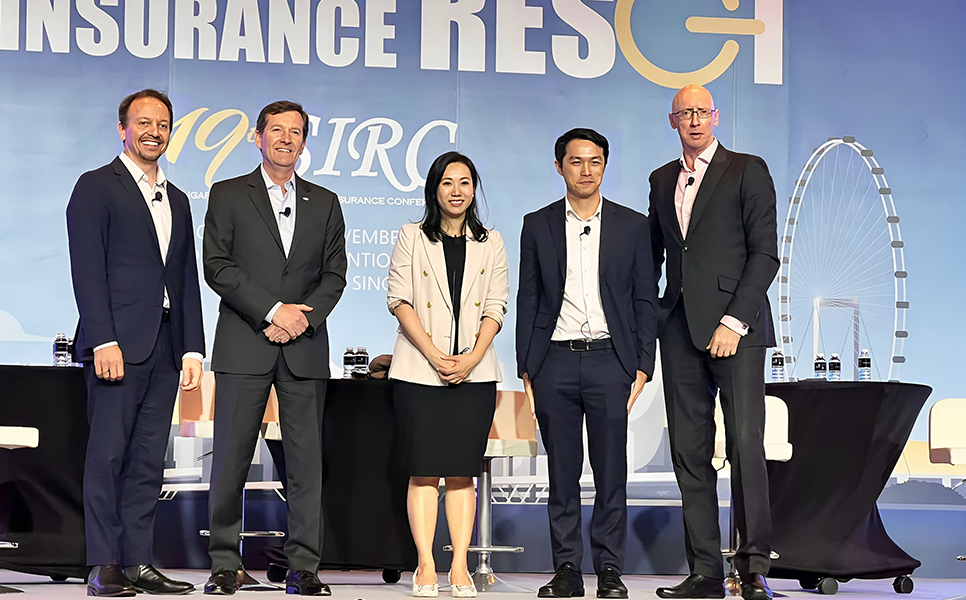Hardening market is an historical anomaly
AM Best’s leading analysts broke down the current issues that contribute to the hardening of the (re) insurance market at a briefing on the second day of SIRC.
By Reva Ganesan
 L-R: Messrs Rob Curtis and Stefan Holzberger, Ms Christie Lee, Messrs Chris Lim and Greg Carter
L-R: Messrs Rob Curtis and Stefan Holzberger, Ms Christie Lee, Messrs Chris Lim and Greg Carter
The hard market environment today is different than the hard markets that we’ve seen in the past.
“Prior hard markets were started by a significant single major catastrophic event, regardless of a natural or a manmade one. And that event led to material capital erosion, that resulted in a sharp rise in premium rates over a short period of time,” said AM Best chief ratings officer Stefan Holzberger.
“The amount of alternative capital in the market has remained constant over the last several years. This time around, we don’t have a single major catastrophic event that has dislocated the market.
“This does not mean there has been no catastrophic activity, but more of an accumulation across the globe of small and medium sized events, rather than that single mega event dislocated the market,” Mr Holzberger said.
Capital remains resilient
There is excess capital in the market and that could continue to grow in 2024.
“We have a stable outlook on the reinsurance segment and there’s a combination of headwinds, tailwinds, opportunities and challenges. One of the challenges is the excess capital in the market today,” he said.
“Reinsurers are being very judicious about the way they deploy that capital. They’re requiring a reasonable return on deployed capital, but that excess capital as we know can lead to overheated competition which drives rates down,” he said.
A notable tailwind Mr Holzberger noted is that the demand has remained strong. There is a huge amount of demand for reinsurance based on the volatility inherent within the insurance marketplace.
No capacity shortage
There’s discipline in the market and reinsurers have woken up to ‘demand appropriate return’ on risk.
“Results are improving, but the investors are taking a wait-and-see approach,” he said.
“Business models are evolving. Many reinsures are moving towards that diversified book of business, both on a geographical as well as the line of business standpoint,” he said.
An upward trend is expected to be seen towards increasing diversification across the reinsurance segment.
Market to continue to harden in North Asia
“We expect the hard market to continue to harden in North Asia. It might take longer than people anticipated until the rate will get adequate and supply and demand to agree fully,” said AM Best senior director Christie Lee.
“I n add it ion, t he i nvest ment env i ron ment i n 2022 wa s ver y challenging, especially for Hong Kong and China base rate shares,” she said.
No capital shortage, just market allocation
“I think the message here is the time it will take to rebalance the whole supply and demand chain and it would require time for communications to travel down from retro to reinsurers to cedants to policyholder,” she said.
“Ultimately, the industry must develop affordable and reasonable structures for supporting policyholders and all these communications perhaps will take a little bit of time to reach the people,” she said.
Reinsurance in Singapore
“Overall, we have seen that there is a good outline curve for the reinsurers that are based in Singapore. Some of the supportive factors for this favourable growth include inflationary pressures as well as more favourable pricing conditions,” said AM Best associate director Chris Lim.
Nat CAT appetite in SEA
Reinsurance appetite for Nat CAT exposed property business in Southeast Asia has diminished and that is generally driven by the increased connectivity that has been observed in the region in recent years.
“The Nat CAT claims are generally far more benign across the year,” he said.
“We have seen some improvements in terms of the results of the underwriting performance for reinsurance and in some cases, these are attributable to extremely favourable pricing conditions.
“There are good improvements of combined ratios for Asian reinsurers. However, there are some discrepancies when we look across to the performance for the regional reinsurers, whereby there were impacts arising from a few other factors that are more specific to the markets,” Mr Lim said.